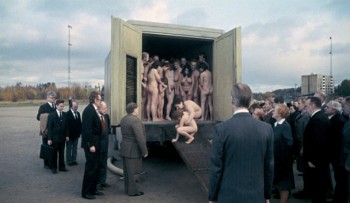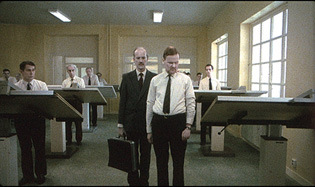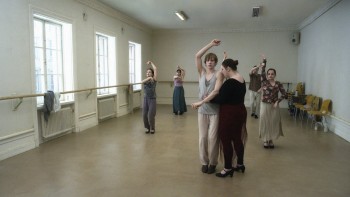.
Roy Andersson’s “World of Glory” opens with unspeakable horror: a truck load of naked people, a child last, are herded into the back of a cube van, the doors locked, and a hose is connected between the truck’s exhaust and the back of the van that holds the people. This allusion to the holocaust is made more horrific by the crowd of people watching on as the scene plays out. Halfway through the scene, and then again at the end, the film’s protagonist looks back at the camera, at those of us watching, drawing attention to our watching: it is an incriminating glance that identifies us with the others who stand idly by. We are complicit.
This horrific spectacle is at odds with the rest of the film’s numb and disassociated narrative. The protagonist who identified our complicit gaze at the beginning of the film directly addresses the audience and introduces us to his mother, the bed he sleeps in, his son, his brother, and various other mundane details as he takes account of his life for and through us. What’s left unresolved by the end of the film is what this mundane life, bracketed by the first scene’s atrocity and the return of the screams at the end, amounts to. What can this one man’s fear of his mortality mean in the face of his complicity in the deaths of so many others?
Andersson fixes the camera on this man’s life, holds the shots painfully long, and chooses a mise-en-scene that agonizingly attends to this man’s life. In her article, “Roy Andersson: From Mordant Ad Director To Philosophical Filmmaker,” Neda Ulaby discusses this style of Andersson’s:
“He eliminates the editing entirely,” Linqvist says. “There is no editing within a single shot. The camera does not move. And so it’s our eye that has to move, has to roam around the picture.” Andersson demands we pay attention; he refuses to manipulate us with close-ups. And his filmic philosophy is also expressed through lighting. “I want to have light without mercy,” he says. “There are no shadows to hide in. You are illuminated all the time. It makes you naked, the human beings — naked.”
“Light without mercy. ” At the screening of his new film at the Toronto International Film Festival last year he added,“So the truth can’t hide.”
Ideologically, Andersson’s style has a lot in common with the Italian neorealists and those who have followed in their footsteps. He uses real people instead of actors, and avoids “artifice in editing, camerawork, and lighting in favor of a simple ‘styless’ style.” The intent here is to lay reality bare.
Andersson departs from the neorealists in how he chooses to stylistically emphasize the bareness. “World of Glory” is clearly an Andersson vision with the washed out florescent lighting, the pale visages of the actors who appear drowned or corpse like, and the staged and theatrical mise-en-scene. In his explanation of his most recent film A Pigeon Sat on a Branch Reflecting on Existence, Andersson describes a connection between reality and fantasy in his work that equally applies to “World of Glory”:
“some of my favourite Neue Sachlichkeit painters include Karl Hofer, Felix Nussbaum and Georg Scholz. Their combination of reality and fantasy resulted in abstracted condensed realism, a kind of “super-realism”, an ambition that I also have for A Pigeon Sat on a Branch, in which abstraction is to be condensed, purified, and simplified; scenes should emerge as cleansed as memories and dreams. Yes this is no easy task: “c’est difficile d’être facile” – it is difficult to be very simple, but I will try.”
In the push to get to the truth in reality, to make it simple, Andersson paradoxically stylizes it, exaggerates it. He condenses the complexities of real life into a simple juxtaposition between atrocity and the mundane.
Andersson connects one man’s mortal fears, the lurid, almost pathetic, small things he holds on to as normalcy against life’s passing, and the awful crime that haunts the film. “World of Glory” suggests that the most remarkable thing in this world is our insensitivity, our passivity, our disconnection. Glory exists is an absence. In his other works, this leads to moments of great awkward laughter, yet here in this small film he holds us to the pain. Maybe in that pain lies the hope of glory.
— R. W. Gray



